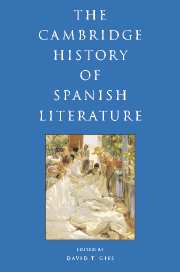Book contents
- Frontmatter
- I INTRODUCTION
- II HISTORY AND CANONICITY
- III THE MEDIEVAL PERIOD
- IV EARLY MODERN SPAIN: RENAISSANCE AND BAROQUE
- V THE ENLIGHTENMENT AND NEOCLASSICISM
- VI THE FORGING OF A NATION: THE NINETEENTH CENTURY
- 22 Romanticism in Spain
- 23 The theatre in Romantic Spain
- 24 Mariano José de Larra
- 25 Romantic poetry
- 26 Romantic prose, journalism, and costumbrismo
- 27 Benito Pérez Galdós
- 28 The Realist novel
- 29 The Naturalist novel
- 30 The theatre in Spain 1850–1900
- 31 Poetry in the second half of the nineteenth century
- VII THE MODERN, MODERNISMO, AND THE TURN OF THE CENTURY
- VIII TWENTIETH-CENTURY SPAIN AND THE CIVIL WAR
- IX IN AND OUT OF FRANCO SPAIN
- X POST-FRANCO SPANISH LITERATURE AND FILM
- Bibliography
- Index
- References
31 - Poetry in the second half of the nineteenth century
from VI - THE FORGING OF A NATION: THE NINETEENTH CENTURY
Published online by Cambridge University Press: 28 March 2008
- Frontmatter
- I INTRODUCTION
- II HISTORY AND CANONICITY
- III THE MEDIEVAL PERIOD
- IV EARLY MODERN SPAIN: RENAISSANCE AND BAROQUE
- V THE ENLIGHTENMENT AND NEOCLASSICISM
- VI THE FORGING OF A NATION: THE NINETEENTH CENTURY
- 22 Romanticism in Spain
- 23 The theatre in Romantic Spain
- 24 Mariano José de Larra
- 25 Romantic poetry
- 26 Romantic prose, journalism, and costumbrismo
- 27 Benito Pérez Galdós
- 28 The Realist novel
- 29 The Naturalist novel
- 30 The theatre in Spain 1850–1900
- 31 Poetry in the second half of the nineteenth century
- VII THE MODERN, MODERNISMO, AND THE TURN OF THE CENTURY
- VIII TWENTIETH-CENTURY SPAIN AND THE CIVIL WAR
- IX IN AND OUT OF FRANCO SPAIN
- X POST-FRANCO SPANISH LITERATURE AND FILM
- Bibliography
- Index
- References
Summary
The kind of poetry written during the second half of the nineteenth century – dominated by Gustavo Adolfo Bécquer (1836–1870), Ramón de Campoamor (1817–1901), and Gaspar Núñez de Arce (1832–1903) – tended to be Romantic, and its possible development into modern poetry was affected by the moral, esthetic, and ideological limits of Spanish Restoration society, a society that was antirevolutionary, at times ultra-Catholic, and almost always idealistic. Poetry was considered to be a mixture of philosophy and science, even though it remained within a didactic realm, as Russell Sebold has indicated in the case of Ramón de Campoamor’s “lecciones de realidad” (“lessons in reality”). Sebold begins his article on a poet frequently thought of as “Realist” by affirming that Campoamor is not a Realist at all. Still, the term “Realist” has been used by Jorge Urrutia and Marta Palenque to describe the poetry written between 1850 and 1900. Urrutia argues for “materialist” content in poetry of Gustavo Adolfo Bécquer in order to indicate the impact of Realism on his verse. At the other end of the spectrum, Joaquín Marco has commented on the difficulty inherent in considering Campoamor’s famous short poem “El tren expreso” (“The Express Train, ” 1872) as Realist, and proposed viewing the author as a poet more allied with the Spanish Restoration. Bécquer generally appears in Spain’s literary history linked to Romanticism, while Campoamor, the author of Doloras (“Aches”), has been seen as part of an anti-Romantic reaction.
It is difficult to define Realist poetry in this period, even if it is done in a fashion as provisional and methodological as that proposed by Urrutia: “La poesía realista es la que se escribe entre el final del romanticismo y la aparición de la poesía moderna: nuevos planteamientos del 98, modernismo, vanguardia” (“Realist poetry is the poetry written between the end of Romanticism and the arrival of modern poetry: the new problems raised by the generation of 98, Modernism, the vanguard”).
- Type
- Chapter
- Information
- The Cambridge History of Spanish Literature , pp. 448 - 458Publisher: Cambridge University PressPrint publication year: 2005



